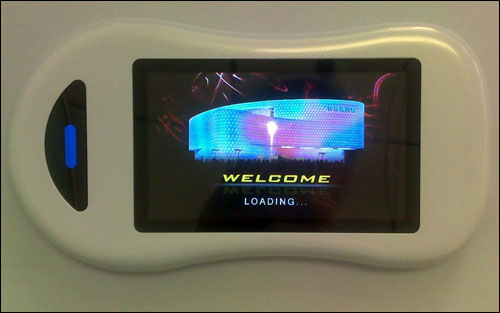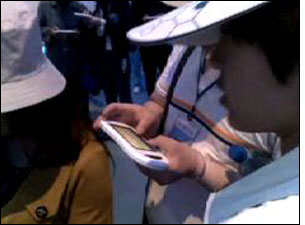Since last month, Shanghai has been hosting the 2010 World Expo, a six-month-long world’s fair that has already racked up 17 million visitors. At least 189 nations and 57 international organizations, as well as a number of cities and corporations, are expected to participate in the event, many of which have erected pavilions to house special exhibits. In the Information and Communications Pavilion (ICP), sponsored by Chinese telecommunications firms China Mobile and China Telecom, an RFID system has been installed to provide visitors with personalized information and solicit their feedback.
As visitors enter the pavilion—a tall, curving structure approximately 6,000 square feet in size—they are provided with a handheld computer, known as an information communications terminal (ICT), designed specifically for the exhibition. Embedded in each device is an active 433 MHz RFID tag, manufactured by Taiwanese firm Champtek. Each guest must enter a name and contact information into the ICT in order to use it. The device’s operating system—developed for the event by Chinese software developer Linkon—collects that individual’s information and associates it with the identification number encoded to its RFID tag.

The ICT serves two purposes: providing each visitor with an electronic tour and navigation guide, and providing a means for China Mobile and China Telecom to easily collect feedback regarding his or her experience and impressions.
The pavilion adopted the slogan “Information and Communication—Extending City Dreams” as its theme, and features exhibits providing a futuristic look at communications systems, as imagined by the sponsors. As such, collecting this survey data is an important means of understanding the types of future communications systems that most interest consumers.
Visitors can utilize the ICT as an interactive guide that will lead them through the pavilion, following the stories of three “dreamers”—characters who share innovative ideas for the future of communication and technology. The overall Expo theme, “Better City, Better Life,” includes environmental sustainability, which is a theme inside the pavilion as well, and this is also reflected in the 35 different interactive displays within the building. For example, patrons are given quizzes regarding how various insects and animals use their senses to communicate.
As a visitor walks through the pavilion, the ICT’s tag transmits its ID number to Champtek’s readers, installed around the displays and kiosks. The Linkon software can determine a user’s location, based on the strength of the tag’s signal that is collected by the readers mounted nearest to that person. After completing a quiz or otherwise interacting with a display or kiosk, the ICT directs the guest, based on his or her location, to the next stop along the tour.

As the visitor moves through the pavilion, the Linkon software builds up a database of information that he or she has learned, along with answers to any quizzes or games he or she has played throughout the tour. This information is used to build up a guest’s personal profile, which that individual can later access online, by logging onto ICP’s Web site. At some displays or kiosks, the visitor is instructed to hold the ICT up to a short-range reader. Doing so triggers a specific video file, linked to that particular display, to play on the ICT screen.
To ensure that the tags would be clearly read despite the presence of other wireless systems—not to mention the use of up to 8,000 ICTs in the pavilion at any given time—Champtek had to carefully tune the readers and use a proprietary anti-collision protocol, says Howard Chen, the VP of Champtek’s Shanghai office.
Before exiting the pavilion, each guest is asked to complete a feedback form that appears on the ICT’s touch screen. The ICT is then cleared of that person’s data, and is issued to another guest. If the visitor attempts to leave the pavilion with the ICT, an alarm will sound—triggered by the device’s RFID tag.
According to Joe Xu, Linkon’s CEO, the pavilion’s operators have reported no problems with the RFID system or the ICTs since the Expo began. The firm is currently marketing the ICT system to other potential end users that require a means of providing tour or navigation systems for events or trade shows, he says, and is about to begin implementations for two new events.

